Rethinking the External Space of Japanese Public Libraries from the Perspective of Urban Sustainability in a Post-Pandemic Era
Abstract
1. Introduction
1.1. Background
1.2. Purpose and Significance
1.3. Literature Review
2. Materials and Methods
2.1. Methods and Definitions
- Collect and explore literature from various fields to discuss the potential and feasibility of using the external space of public libraries in Japan from a theoretical perspective, and the role this could play in the sustainability of the city.
- To understand the current state of external space through case studies.
- To discuss feasible strategies for regenerating the external space of libraries in relation to the theoretical and current situation.
2.2. Case Selection and Distribution
2.3. Data Collection Process
- Information collection for the case building was divided into two periods. Information from 1980 to 2006 was well documented in a collection of works published by the Japan Library Association (JLA) [38]. Basic information for 2007–2022 needed to be collected through multiple channels, such as the official websites of the libraries or the official websites of the design firms.
- The survey of the external space and environment of Japanese public libraries was jointly completed through Google Earth, the map of the National Geological Institute of Japan, and Google Street View. Accuracy was ensured through multiple verifications.
- The investigation of the external space elements of the library was mainly completed through Google Earth and Google Street View. We reached out to the libraries where we could not see the external spaces using Google Maps or Google Street View, and the librarians provided photos of the space but did not authorize for these to be made public. If no librarians responded, we conducted fieldwork in person.
3. Results
3.1. Potential of External Space for Urban Sustainability
3.2. Spatial Analysis of External Space
3.2.1. External Space Elements Composition
3.2.2. External Space Form
- To determine the spatial relationship between the external space of the public library and the building.
- To determine the spatial continuity between the external and external spaces.
4. Discussion
- Enhancing the library’s interaction with the city by increasing the transparency of the facade. The ability to see the activities inside the library enhances the sense of normality and increases the vitality of the city. This could attract more users to the library.
- Use external spaces as urban public spaces. External public spaces in libraries can help increase the possibility of intergenerational communication and provide social space for work-at-home residents. For the library, public spaces provide the possibility of business opportunities. In the post-pandemic period, Japan changed from a model of unipolarity and local decline in Tokyo to a model of multi-point networks [54]. There are more opportunities for piecemeal businesses in communities now. Semi-outdoor space close to the entrance is often suitable for hosting social activities.
- Provide seating in the exterior space. Outdoor seating adds resilience to the city while extending the service hours of public libraries. Seating can be installed in all directions of the library and can support different types of activities depending on the location.
- Provide outside spaces to support work, meetings, and education. The post-pandemic era has led to public libraries performing new functions as information exchange centers. Libraries must be prepared for the era of online work and learning. Because work and meetings require a certain level of privacy, they are better suited to atrium, backyard, or rooftop spaces. Off-line activities can also help the library [55].
- Events in exterior spaces are an extension of public libraries’ activities and can be used as a medium to better communicate the library’s impact on the city. Events in public spaces could be useful for attracting potential users and activating cities. Display activities are more appropriate at the interface with the city, particularly in the entrance spaces.
- Including more green spaces in external spaces. Intensive cities require additional functional public facilities. At the same time, in the post-pandemic era, there is also a need to provide more green spaces at the community scale to meet residents’ health needs. In addition to improving the reading environment, green spaces can also inject more vitality into the library from crowds attracted by the landscape. If there is insufficient space for landscaping at the site, the surrounding green resources can be maximized.
5. Conclusions
Author Contributions
Funding
Data Availability Statement
Conflicts of Interest
References
- Moglia, M.; Frantzeskaki, N.; Newton, P.; Pineda-Pinto, M.; Witheridge, J.; Cook, S.; Glackin, S. Accelerating a green recovery of cities: Lessons from a scoping review and a proposal for mission-oriented recovery towards post-pandemic urban resilience. Dev. Built Environ. 2021, 7, 100052. [Google Scholar] [CrossRef]
- Glackin, S.; Moglia, M.; Newton, P. Working from home as a catalyst for urban regeneration. Sustainability 2022, 14, 12584. [Google Scholar] [CrossRef]
- Barbarossa, L. The post pandemic city: Challenges and opportunities for a non-motorized urban environment. An overview of Italian cases. Sustainability 2020, 12, 7172. [Google Scholar] [CrossRef]
- Kawaguchi, T. The Development of telework in Japan and its geographical implications. Sundai Hist. Rev. 2020, 170, 105–139. [Google Scholar]
- Konagaya, K. Urban structure and urban industries in the age after/with COVID-19: The third way policy. Urban Manag. Res. 2021, 1, 47–72. [Google Scholar]
- Ota, C.; Minai, N. Changes in community bus usage and living environment during the COVID-19 pandemic. Rep. City Plan. Inst. Jpn. 2022, 21, 71–74. [Google Scholar] [CrossRef]
- Ichinose, T. From walking for health to building sustainable cities. IATSS Rev. 2022, 47, 22–32. [Google Scholar]
- Miyahara, M.; Tsukuda, H. A study on workspaces environment during teleworking from home. Trans. AIJ J. Archit. Plan. Environ. Eng. 2021, 86, 2541–2548. [Google Scholar] [CrossRef]
- Kondo, N.; Tanaka, K. Impact of spatial realignment of community streets on traffic calming and promotion of physical activity. J. City Plan. Inst. Jpn. 2022, 57, 1295–1300. [Google Scholar] [CrossRef]
- Campisi, T.; Basbas, S.; Skoufas, A.; Akgün, N.; Ticali, D.; Tesoriere, G. The impact of COVID-19 pandemic on the resilience of sustainable mobility in Sicily. Sustainability 2020, 12, 8829. [Google Scholar] [CrossRef]
- Hasegawa, D.; Eom, S.; Nishihori, Y. Change in public transportation accessibility and relationship with floating population change pattern. J. City Plan. Inst. Jpn. 2022, 57, 1281–1287. [Google Scholar] [CrossRef]
- Suzuki, Y.; Yamazaki, M.; Mimura, Y. The Study on the relationship between going-out activities and stress/a sense of purpose in life in the COVID-19. J. City Plan. Inst. Jpn. 2022, 57, 1164–1171. [Google Scholar] [CrossRef]
- Sugama, A.; Okumura, M. Sustainable network redesign of transit service in urban outskirts. J. City Plan. Inst. Jpn. 2021, 56, 865–872. [Google Scholar] [CrossRef]
- Fang, Y.; Yoshimura, Y. Case studies of temporary urban intervention in public spaces during COVID-19: Strategy for freedom and control. Trans. AIJ J. Archit. Plan. Environ. Eng. 2023, 88, 180–190. [Google Scholar] [CrossRef]
- Mori, R.; Hashimoto, K. Research on the characteristics of choosing a place to stay in public space. Man-Environ. Res. Assoc. J. 2018, 21, 37. [Google Scholar]
- Yuasa, K.; Song, J.; Izumiyama, R.; Miura, S.; Murakami, S. Trends in outdoor space usage under the influence of COVID-19 infection. Trans. AIJ J. Archit. Plan. Environ. Eng. 2021, 86, 2677–2688. [Google Scholar] [CrossRef]
- Funabiki, E.; Katayama, I. Impact of “new lifestyle” on the stop/stay action of users of public spaces: JR Osaka Station Atrium Square as the subject. AIJ J. Technol. Des. 2021, 27, 1379–1383. [Google Scholar] [CrossRef]
- Zang, T.; Zhou, T.; He, X.; Yang, X.; Ikebe, K. Rethinking Japanese public libraries from the perspective of time. Sustain. Cities Soc. 2022, 87, 104222. [Google Scholar] [CrossRef]
- Kamińska, A.M.; Opaliński, Ł.; Wyciślik, Ł. The landscapes of sustainability in the library and information science: Systematic literature review. Sustainability 2022, 14, 441. [Google Scholar] [CrossRef]
- Jiang, Y.; Chen, Y.; Wu, Y.; Yang, X.; Yu, W. Are librarians ready for space transformation? A systematic review of spatial literacy for librarians. Sustainability 2023, 15, 3244. [Google Scholar] [CrossRef]
- Nakamura, K.; Kurihara, K. The models of catchment area of community library according to scale: Fundamental investigation for the planning of library system to community area (10). Trans. AIJ J. Archit. Plan. Environ. Eng. 1997, 62, 97–104. [Google Scholar]
- Nakai, T. Research on Library Planning in Sparsely Populated Areas Based on the Dual Structure of Usage Areas; Mie University: Tsu, Japan, 2000. [Google Scholar]
- Nagatsuka, T. Makerspace in Public Libraries during the COVID-19 Outbreak. Present and future possibilities of remote service introduced recently. Prepr. Inf. Prof. Symp. 2021, 2021, 55–60. [Google Scholar]
- Nakayama, M. Japanese public libraries’ approach to COVID-19: Perspectives from Library Outreach Services. Otsuma Women’s University annual report. Humanit. Soc. Sci. 2022, 54, 110–122. [Google Scholar]
- Alajmi, B.M.; Albudaiwi, D. Response to COVID-19 pandemic: Where do public libraries stand? Public Libr. Q. 2021, 40, 540–556. [Google Scholar] [CrossRef]
- Yazaki, Y.; Kurita, O. Analysis of public library location focusing on library desert. J. City Plan. Inst. Jpn. 2019, 54, 1504–1511. [Google Scholar] [CrossRef]
- Igari, S.; Nakade, B.; Higuchi, S. A study on the location and utilization of libraries in the local cities. J. City Plan. Inst. Jpn. 2004, 39, 559–564. [Google Scholar] [CrossRef]
- Kim, J.; Lee, J. An analysis of spatial accessibility changes according to the attractiveness index of public libraries using social media data. Sustainability 2021, 13, 9087. [Google Scholar] [CrossRef]
- Osaka, J. Private sector utilization in the development and operation of public facilities: Directions and issues in PPP/PFI promotion. Issue Brief 2017, 952, 1–11. [Google Scholar]
- Sasabe, T. Flexibility in local libraries as public spaces: A case study of Tsutaya Library. Annu. Rev. Inst. Adv. Soc. Res. 2019, 16, 77–84. [Google Scholar]
- Fuzimoto, K.; Kana, K.; Akasaki, K. A study on the use realities of the sidewalk cafe on the public space of Kyoubashi riverside in Hiroshima city, and resident’s consciousness to the space. J. City Plan. Inst. Jpn. 2008, 43, 619–624. [Google Scholar] [CrossRef]
- Izumiyama, R.; Akiyama, H.; Kobayashi, M. Study on the application and management of “privately owned public spaces” in the urban central area: Through research and analysis to community management organization registration system the Tokyo Municipal Ordinance on promoting the creation SYARETA-MACHINAMI of Tokyo. Trans. AIJ J. Archit. Plan. Environ. Eng. 2015, 80, 915–922. [Google Scholar]
- Toki, A.; Kajima, M. Practical use model from spatial composition and multipurpose of parking lots in the central area of mito: A study on design method of plaza type parking lots in local cities. Trans. AIJ J. Archit. Plan. Environ. Eng. 2010, 75, 2213–2220. [Google Scholar]
- Tanaka, R.; Murase, H.; Nakai, T. A study of ideal composite depend of the usage behavior and use sphere of the compound facilities with the library. Proc. Tokai Chapter Archit. Res. Meet. 2016, 54, 381–384. [Google Scholar]
- Gehl, J.K.J. Life between Buildings: Using Public Space; Island Press: Washington, DC, USA, 2011. [Google Scholar]
- Yuasa, K.; Ikebe, K. Management and public space concepts in the case of adjacent public facilities and urban parks. Landsc. Archit. Res. 2018, 81, 583–588. [Google Scholar] [CrossRef]
- Kawanami, M.; Oi, N. A study of continuity between indoor space and outdoor space: The concept of continuity and the influence of border. Res. Rep. Kyushu Branch Archit. Inst. Jpn. 2 Dep. Environ. 2002, 41, 101–104. [Google Scholar]
- Association, J.L. The Library Architecture Award of JLA, 1985–2006; Japan Library Association: Tokyo, Japan, 2007. [Google Scholar]
- Aoyama, Y.; Kondo, A. The optimal distance between residential location and urban facility. J. City Plan. Inst. Jpn. 1986, 21, 295–300. [Google Scholar] [CrossRef]
- Fujisawa, M. Intersection of inside and outside museums. Gakujutsu Kenkyu Educ. Acad. Stud. 2009, 57, 7–19. [Google Scholar]
- Sonoda, S.; Nozawa, Y. A study on the conversion of low-unused land to public space by chain reaction: The case of Waiwai!! container project in Saga city. AIJ J. Technol. Des. 2015, 21, 297–300. [Google Scholar] [CrossRef]
- Ushiyama, Y.; Takata, N. A study on the vague boundaries around the openings of contemporary houses in city. Archit. Plan 2013, 2013, 649–650. [Google Scholar]
- Tooya, A.; Kana, K.; Hisao, H. Study on the yearly change of activity of users in public space. In case of the street furniture setting social experiment in western sidewalk of north building of Grand Front Osaka. J. City Plan. Inst. Jpn. 2019, 54, 375–382. [Google Scholar] [CrossRef]
- Seta, S.; Matsumoto, N.; Takagi, K.; Miwa, N. The influence of the urban space elements upon the estimation of sensitivity analysis: Notation of emotional meaning of urban outdoor spaces based on brain waves Part 2. Trans. AIJ J. Archit. Plan. Environ. Eng. 2004, 69, 65–72. [Google Scholar]
- Kawamura, Y. Analysis of the Residents’ Behavior of Library Use in the Cities with Good Access to Libraries in a Widespread Area: A Study of Regional Planning of Public Libraries; University of Tsukuba: Tsukuba, Japan, 2010. [Google Scholar]
- Naganuma, R.; Yoshikawa, M.; Hirakawa, R.; Komada, H.; Nakai, T. Usage behavior based on the expansion of usage areas and user attributes: A study of organically connected library networks in local cities, part 2. Collect. Res. Rep. Kanto Branch Archit. Inst. Jpn. 2020, 90, 295–298. [Google Scholar]
- Li, J.; Oi, N. Behavioral situations and intention to use public spaces. Man -Environ. Res. Assoc. J. 2019, 22, 30. [Google Scholar]
- Sakai, K.; Oshima, H. Present status of installed library and facilities, and influence that facilities give to number of visitors of library: Study on library planning which established in the complex facility, Part 1. Trans. AIJ J. Archit. Plan. Environ. Eng. 2018, 83, 1909–1918. [Google Scholar] [CrossRef]
- Furuta, D.; Kojima, Y.; Komatsu, H. Tendency of spaces and operation in japanese public libraries from the viewpoint of citizens’ multipurpose uses. Trans. AIJ J. Archit. Plan. Environ. Eng. 2019, 84, 1057–1065. [Google Scholar] [CrossRef]
- Kitamura, A. A “Place outside the home” in older adults. Life Des. Rep. 2013, 205, 35–37. [Google Scholar]
- Hino, K.; Ishii, N. Utilization of third places among elderly people and their significance. Trans. AIJ J. Archit. Plan. Environ. Eng. 2014, 79, 2471–2477. [Google Scholar]
- Tsuji, M.; Watanabe, H.; Fujimaki, K.; Katō, S. Community platform creation through the use of public spaces: Machikado Share initiative in Miyamae-ku, Kawasaki City. J. Hous. Res. Found. “Jusoken” 2022, 48, 209–218. [Google Scholar]
- Japan Library Association. Japan Library Statistics. 2021. Available online: http://www.jla.or.jp/library/statistics/tabid/94/Default.aspx (accessed on 7 May 2023).
- Shirato, S.-I. Current status and issues of urban regeneration policies: On the case of Kawagoe-City. Meiji Univ. Glob. Jpn. Stud. 2022, 14, 69–87. [Google Scholar]
- Kuno, K. A study on the new and critical methodology of “library as place”. Libr. World 2014, 66, 268–285. [Google Scholar]
- Mumford, L. The City in History: Its Origins, Its Transformations, and Its Prospects; Penguin Books: London, UK, 1991. [Google Scholar]
- Claudelin, A.; Tuominen, K.; Vanhamäki, S. Sustainability perspectives of the sharing economy: Process of creating a library of things in Finland. Sustainability 2022, 14, 6627. [Google Scholar] [CrossRef]
- Izumiyama, R.; Ishida, Y. Trial of a human resources development program for public space utilization through “Park(ing) Day” using on-street parking spaces—Through Sotonova Studio and “Park(ing) Day” 2019 Shibuya Miyamasuzaka. Urban Plan. 2020, 2020, 1045–1046. [Google Scholar]
- Barclay, D.A. Space and the social worth of public libraries. Public Libr. Q. 2017, 36, 267–273. [Google Scholar] [CrossRef]
- Shimizu, H.; Murooka, T.; Taniguchi, M. Realizing a 15-minute city in Metropolitan Tokyo. J. City Plan. Inst. Jpn. 2022, 57, 592–598. [Google Scholar] [CrossRef]
- Kujawski, A.; Nürnberg, M. Analysis of the potential use of unmanned aerial vehicles and image processing methods to support road and parking space management in urban transport. Sustainability 2023, 15, 3285. [Google Scholar] [CrossRef]
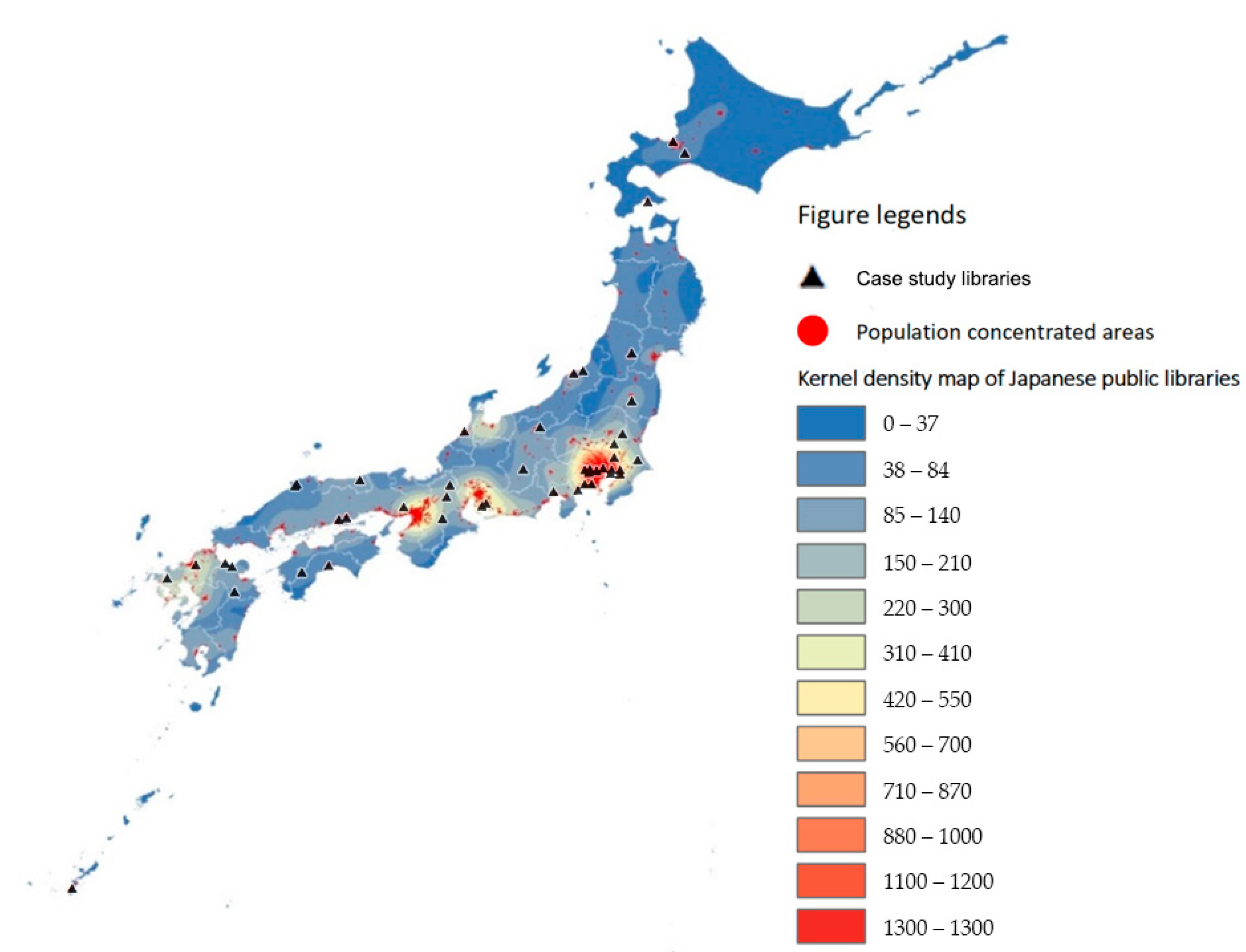
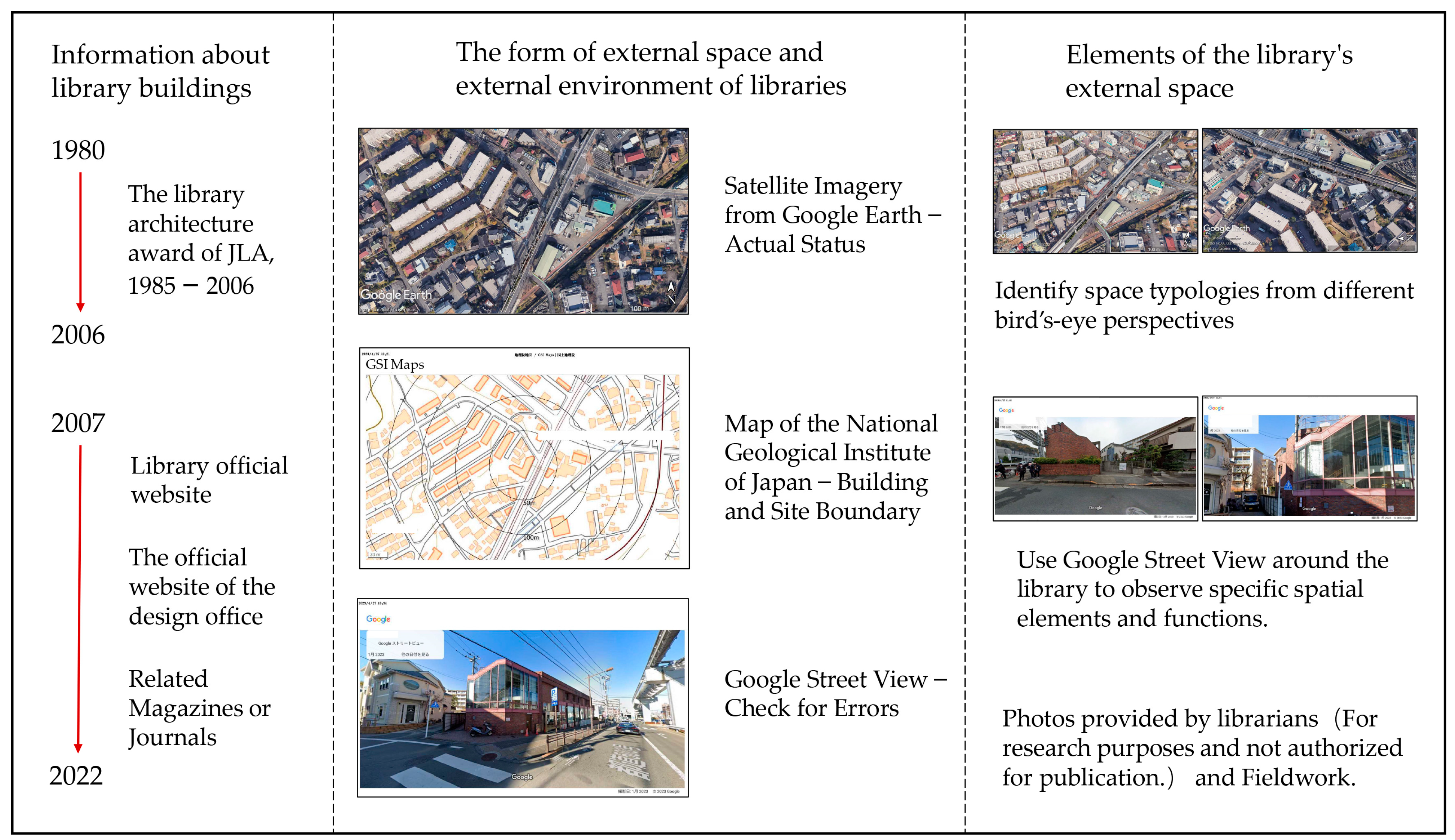
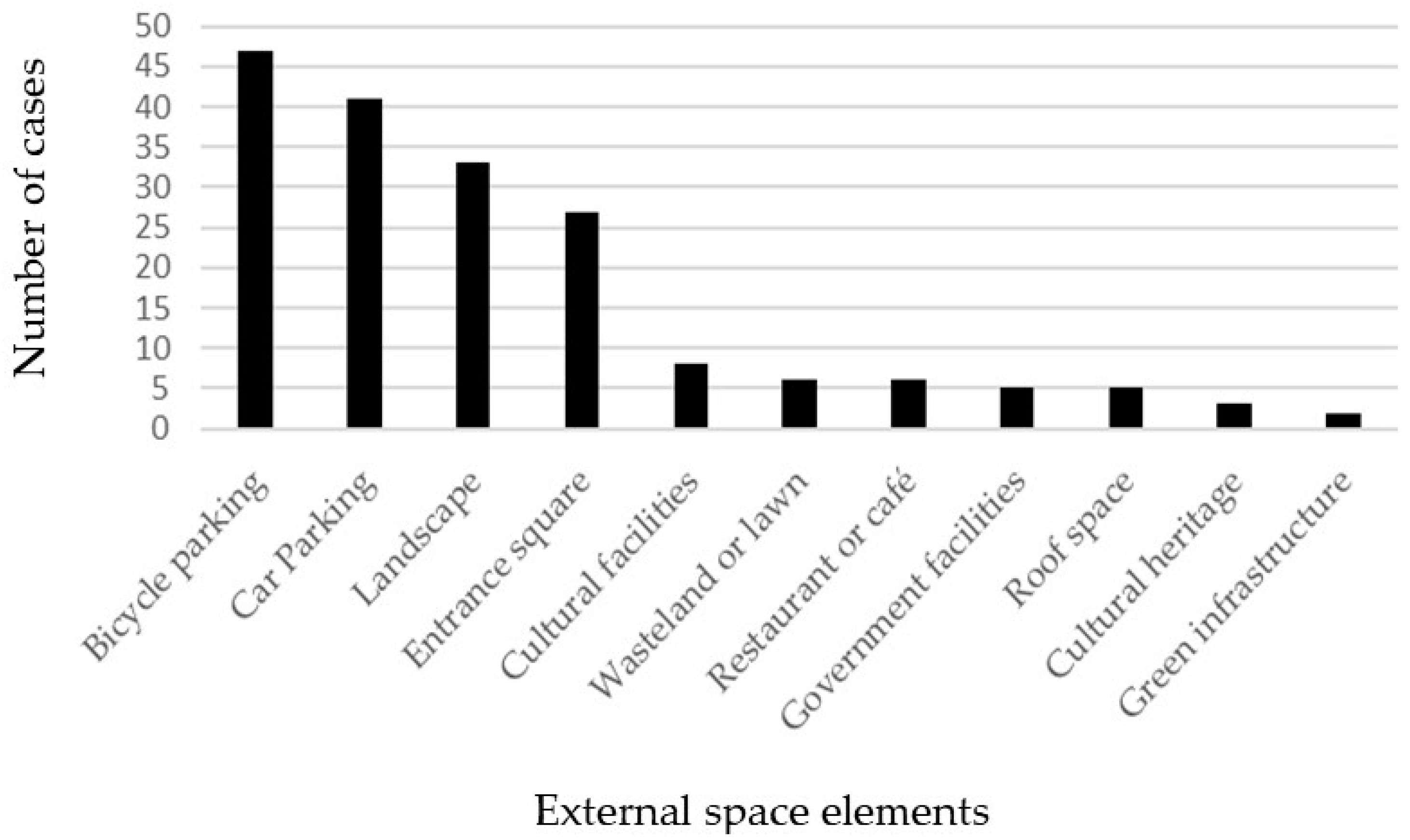
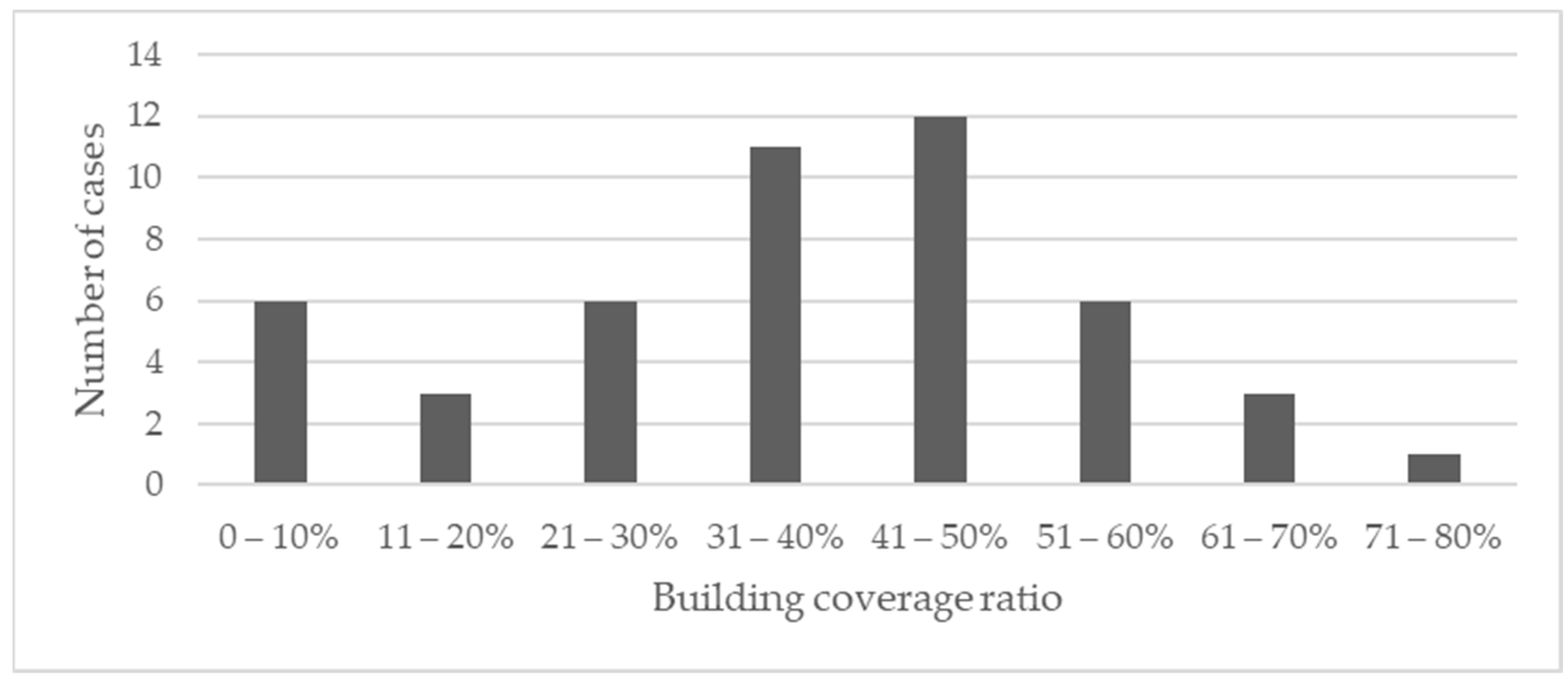

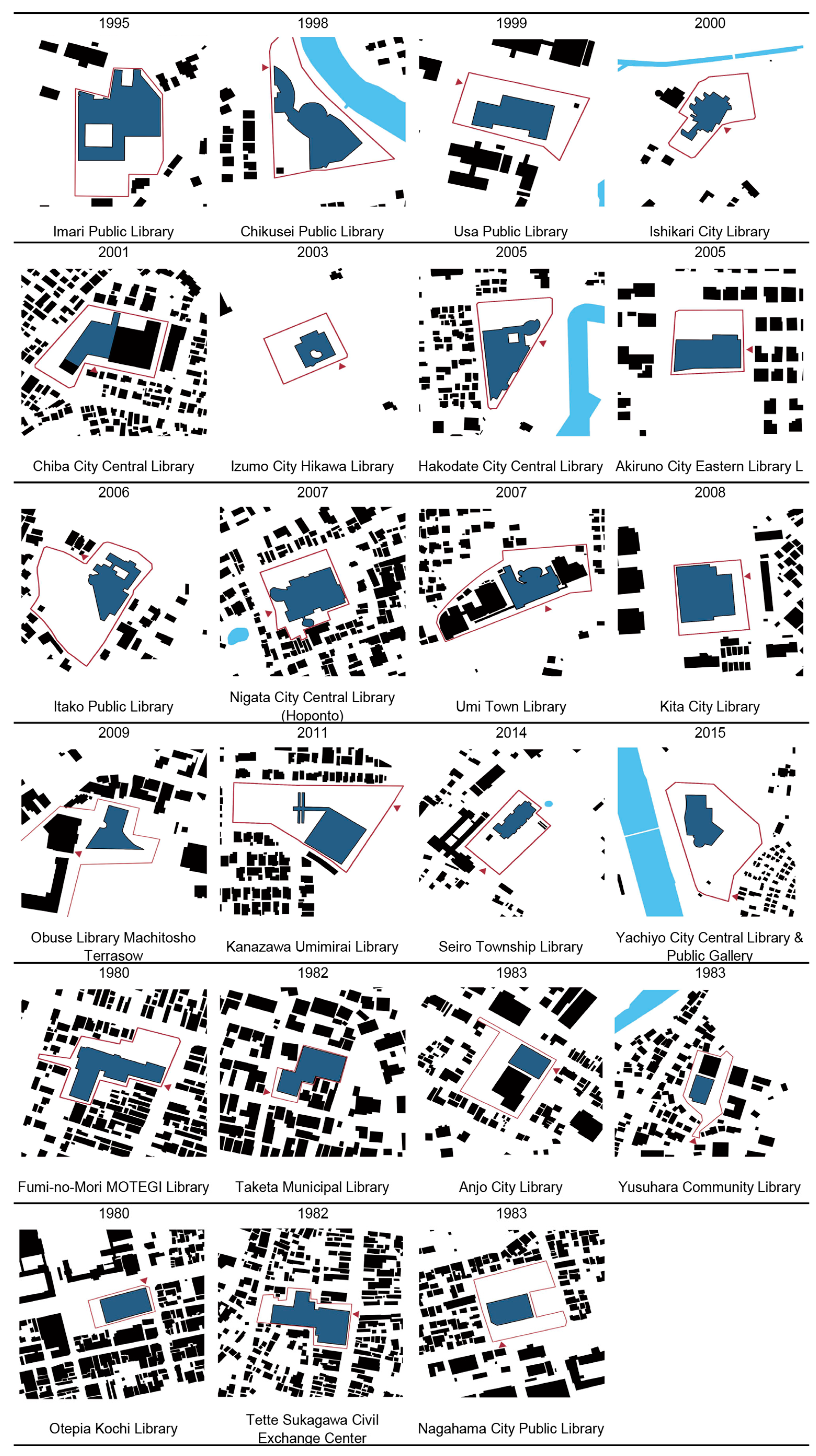
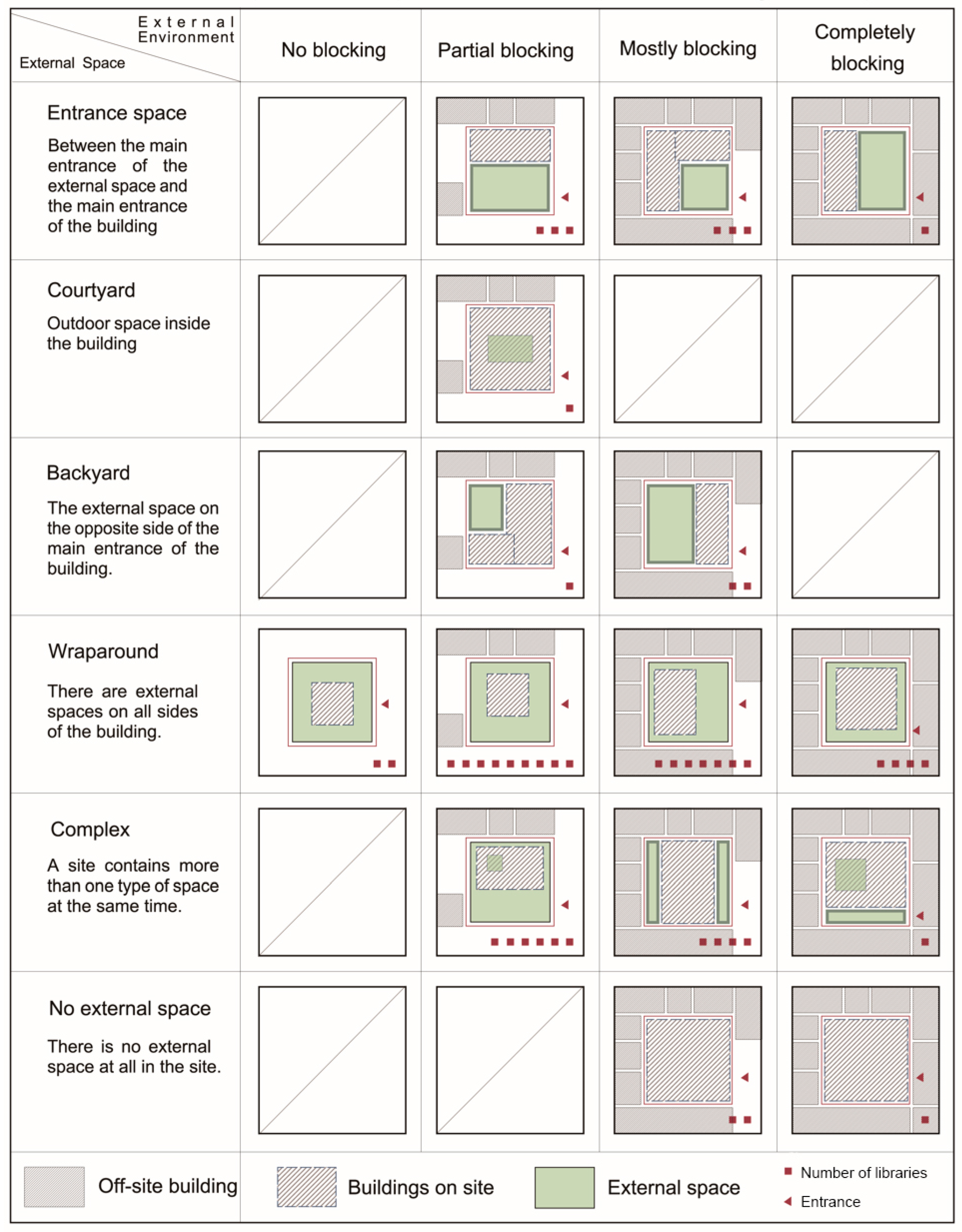


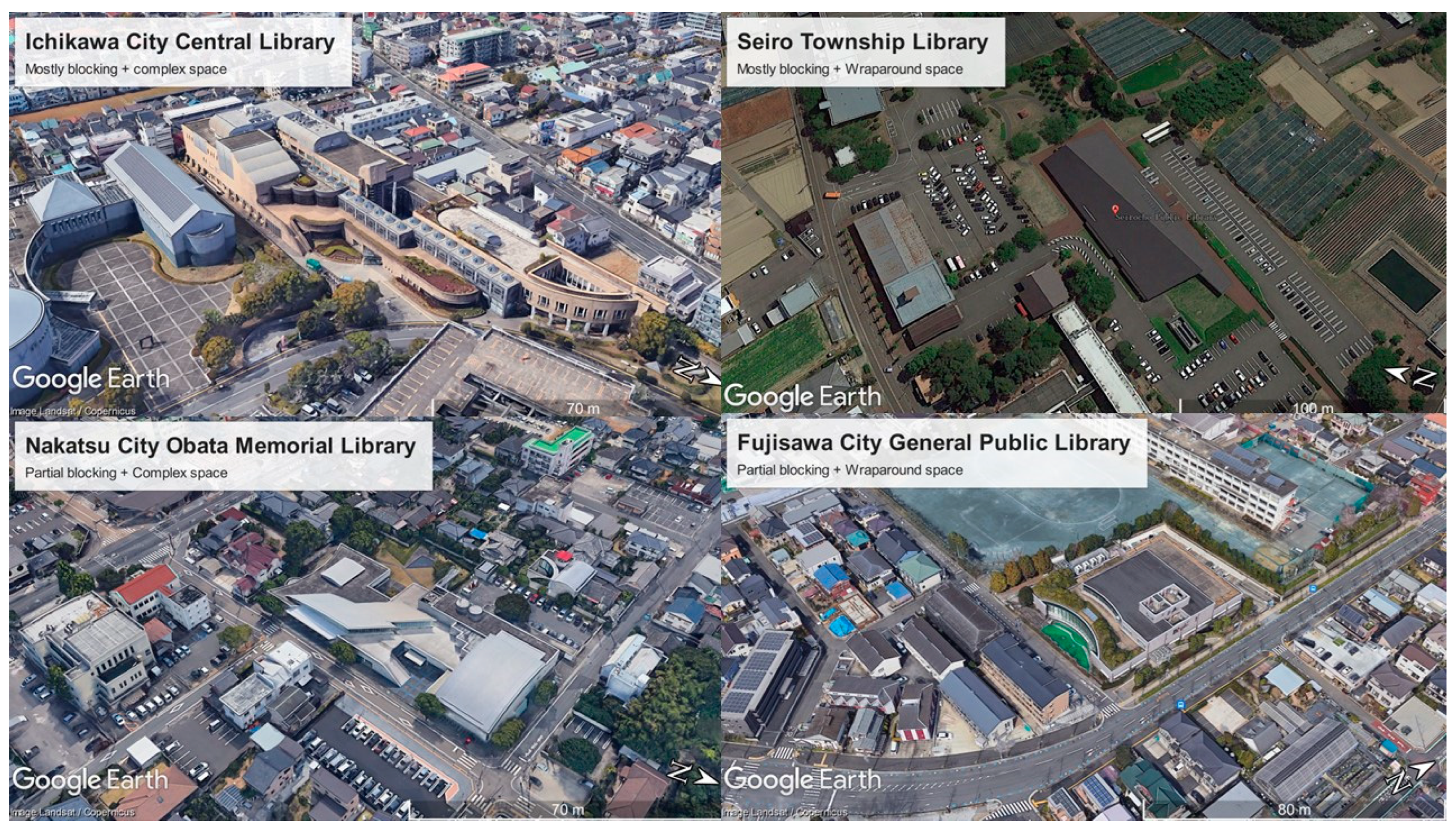

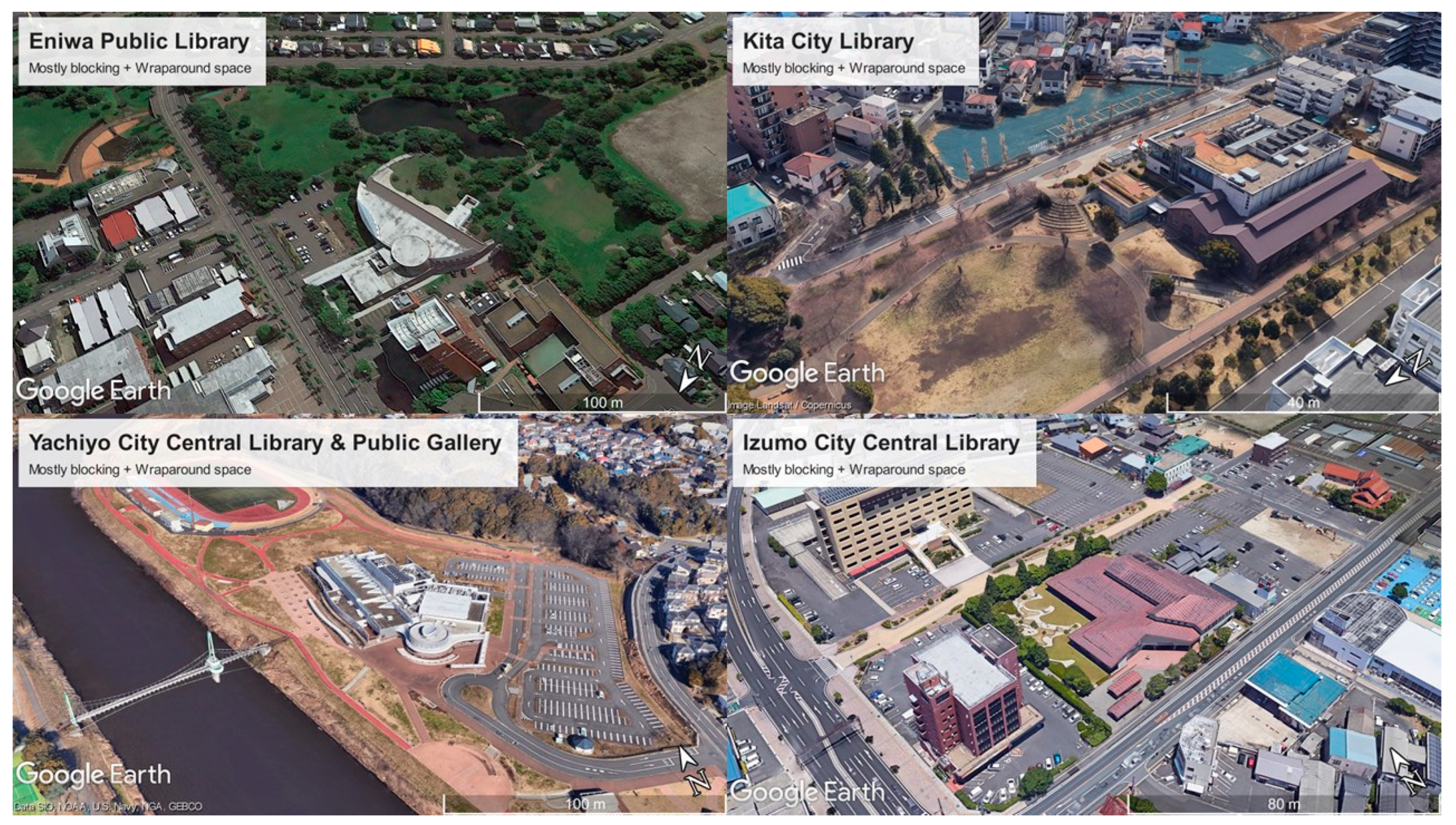
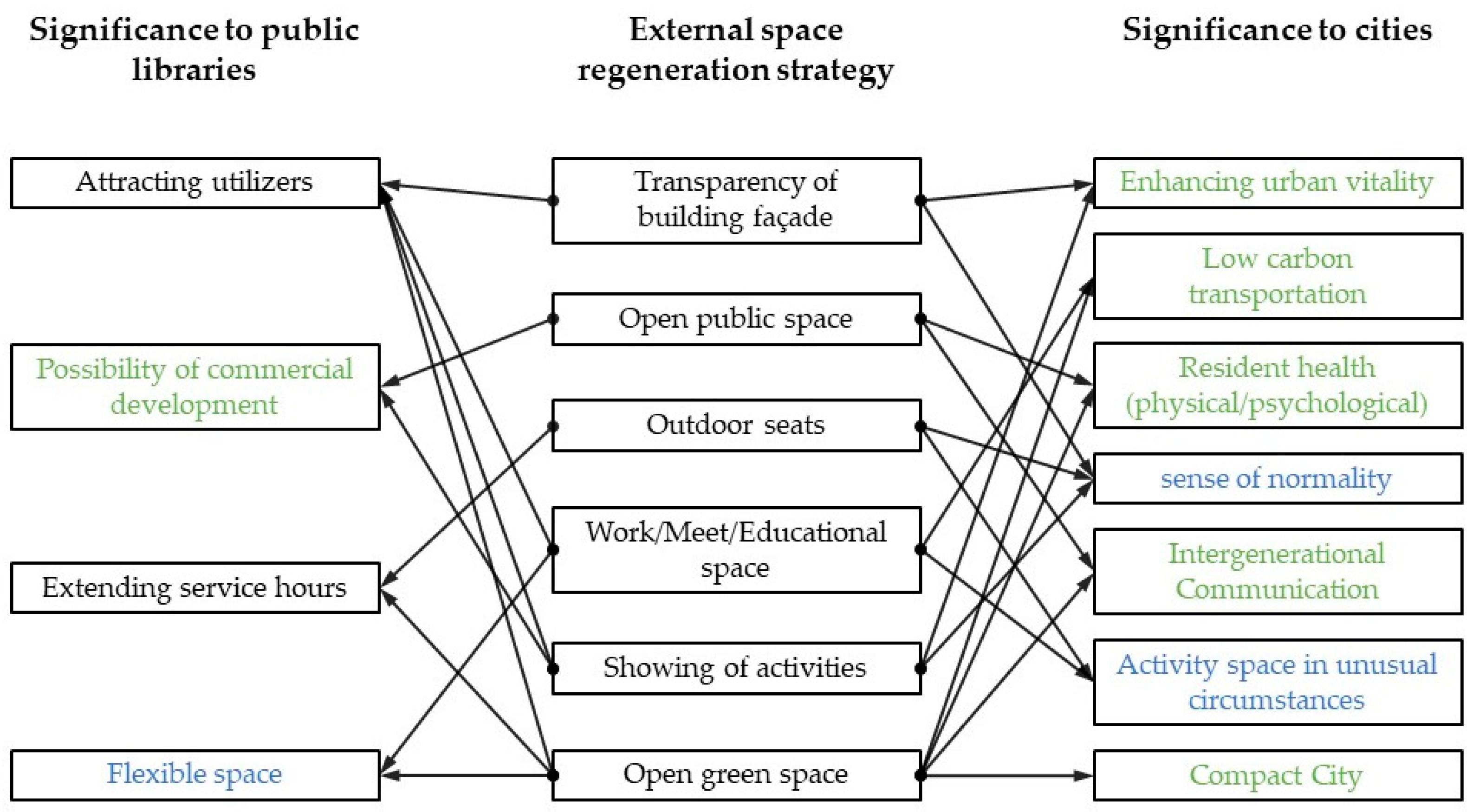
| Year of Completion | Library Name | Building Foot Print (m2) | Site Area (m2) | Building/Site | Capacity of Book Storage |
|---|---|---|---|---|---|
| 1980 | Hino City Takahata Library | 583 | 1086 | 54% | 60,000 |
| 1982 | Joso City Public Library | 1231 | 4066 | 30% | 80,000 |
| 1983 | Urayasu City Central Library | 2953 | 5296 | 56% | 200,000 |
| 1983 | Okayama City Central Library | 2952 | 9143 | 32% | 800,000 |
| 1983 | Kura City Central Library | 1400 | 14,819 | 9% | 400,000 |
| 1983 | Tendo City Library | 1873 | 4292 | 44% | 180,000 |
| 1984 | Izumo City Central Library | 2017 | 4812 | 42% | 170,000 |
| 1984 | Higashitamato City Central Library | 1440 | 23,042 | 6% | 188,000 |
| 1985 | Urasoe city library | 1782 | 4252 | 42% | 300,000 |
| 1985 | Yokaichi Public Library | 1363 | 7596 | 18% | 150,000 |
| 1986 | Fujisawa City General Public Library | 2471 | 4726 | 52% | 350,000 |
| 1986 | Komagane City Library | 991 | 9836 | 10% | 100,000 |
| 1987 | Musashino City Kichijoji Library | 603 | 864 | 70% | 75,000 |
| 1987 | Urayasu City Central Library | 1741 | 6582 | 26% | 150,000 |
| 1989 | Fujinomiya City Central Library | 2006 | 4723 | 42% | 376,000 |
| 1989 | Isehara city library | 2921 | 3889 | 75% | 220,000 |
| 1990 | Tottori Prefectural Library | 3035 | 29,681 | 10% | 1,141,000 |
| 1990 | Sanda City Library | 2082 | 5630 | 37% | 180,000 |
| 1990 | Ishigaki City Library | 2264 | 6329 | 36% | 250,000 |
| 1992 | Eniwa Public Library | 2610 | 9520 | 27% | 292,000 |
| 1993 | Hekinan City Library | 5425 | 10,927 | 50% | 400,000 |
| 1993 | Nakatsu City Obata Memorial Library | 2385 | 5644 | 42% | 110,000 |
| 1994 | Ichikawa City Central Library | 6164 | 11,012 | 56% | 1,094,000 |
| 1994 | Odawara City gull library | 3627 | 9112 | 40% | 170,000 |
| 1995 | Imari Public Library | 4054 | 7692 | 53% | 300,000 |
| 1998 | Chikusei Public Library | 3558 | 7835 | 45% | 316,000 |
| 1999 | Usa Public Library | 2580 | 7156 | 36% | 210,000 |
| 2000 | Ishikari City Library | 3466 | 9000 | 39% | 300,000 |
| 2001 | Chiba City Central Library | 3975 | 12,775 | 31% | 1,125,000 |
| 2003 | Izumo City Hikawa Library | 2781 | 10,393 | 27% | 168,000 |
| 2005 | Hakodate City Central Library | 5143 | 11,707 | 44% | 730,000 |
| 2005 | Akiruno City Eastern Library L | 920 | 1721 | 53% | 101,000 |
| 2006 | Itako Public Library | 2585 | 11,771 | 22% | 186,000 |
| 2007 | Nigata City Central Library (Hoponto) | 4556 | 9914 | 46% | 458,000 |
| 2007 | Umi Town Library | 4065 | 13,093 | 31% | 140,000 |
| 2008 | Kita City Library | 2699 | 5725 | 47% | 414,000 |
| 2009 | Obuse Library Machitosho Terrasow | 998 | 10,511 | 9% | 49,000 |
| 2011 | Kanazawa Umimirai Library | 2112 | 11,763 | 18% | 400,000 |
| 2014 | Seiro Township Library | 2606 | 15,448.00 | 17% | 200,000 |
| 2015 | Yachiyo City Central Library & Public Gallery | 3500 | 12,073 | 29% | 460,000 |
| 2016 | Fumi-no-Mori MOTEGI Library | 2977 | 6414 | 46% | 125,000 |
| 2017 | Taketa Municipal Library | 1239 | 2800 | 44% | 137,000 |
| 2017 | Anjo City Library | 2403 | 6914 | 35% | 450,000 |
| 2018 | Yusuhara Community Library | 1170.5 | 3088 | 38% | 90,000 |
| 2018 | Otepia Kochi Library | 4216.26 | 6606 | 64% | 2,050,000 |
| 2019 | Tette Sukagawa Civil Exchange Center | 4877 | 7724 | 63% | 237,000 |
| 2019 | Nagahama City Public Library | 2728.7 | 7377 | 37% | 300,000 |
Disclaimer/Publisher’s Note: The statements, opinions and data contained in all publications are solely those of the individual author(s) and contributor(s) and not of MDPI and/or the editor(s). MDPI and/or the editor(s) disclaim responsibility for any injury to people or property resulting from any ideas, methods, instructions or products referred to in the content. |
© 2023 by the authors. Licensee MDPI, Basel, Switzerland. This article is an open access article distributed under the terms and conditions of the Creative Commons Attribution (CC BY) license (https://creativecommons.org/licenses/by/4.0/).
Share and Cite
Zang, T.; Jiang, J.; Ikebe, K.; Kinoshita, T. Rethinking the External Space of Japanese Public Libraries from the Perspective of Urban Sustainability in a Post-Pandemic Era. Sustainability 2023, 15, 7796. https://doi.org/10.3390/su15107796
Zang T, Jiang J, Ikebe K, Kinoshita T. Rethinking the External Space of Japanese Public Libraries from the Perspective of Urban Sustainability in a Post-Pandemic Era. Sustainability. 2023; 15(10):7796. https://doi.org/10.3390/su15107796
Chicago/Turabian StyleZang, Tongguang, Jun Jiang, Konomi Ikebe, and Takeshi Kinoshita. 2023. "Rethinking the External Space of Japanese Public Libraries from the Perspective of Urban Sustainability in a Post-Pandemic Era" Sustainability 15, no. 10: 7796. https://doi.org/10.3390/su15107796
APA StyleZang, T., Jiang, J., Ikebe, K., & Kinoshita, T. (2023). Rethinking the External Space of Japanese Public Libraries from the Perspective of Urban Sustainability in a Post-Pandemic Era. Sustainability, 15(10), 7796. https://doi.org/10.3390/su15107796






